Make a batch of authentic focaccia Barese from the city of Bari in Italy. This crispy, yet light, focaccia bread is topped with tomatoes, olives, and oregano.

Want To Save This Article?
Enter your email below and we'll send it straight to your inbox. Plus, you'll receive new weekly recipe inspiration.
After attending culinary school in Italy, I grew to love making all types of focaccia. Italian food is very regionally based, meaning that different regions have their own take on the classic focaccia bread.
While the Tuscany region has its focaccia called schiacciata, known for being thinner and perfect for sandwiches, the Puglia region adds tomatoes to its focaccia, and Liguria makes focaccia Genovese. The focaccia I'm teaching you about today is also from Puglia, specifically from the city of Bari.
What makes this Barese style of focaccia unique is the round shape, the addition of potato into the dough, along with the delicious toppings of tomatoes, olives, and oregano. This is a bread that's soft inside, yet has a crispy exterior crust.
For more focaccia, check out this list of the best Italian focaccia bread recipes.
Jump to:
What You'll Learn In This Recipe
- How to make an authentic Italian focaccia recipe with step-by-step photos. I'll walk you through everything so you don't have to be scared about making homemade bread.
- The importance of each ingredient in this focaccia Barese bread.
- How to store and reheat focaccia, so it always tastes fresh and delicious.
Ingredients You Need
Focaccia Barese requires a few unique ingredients in addition to your normal bread baking essentials.

- Potato: Potato is a unique ingredient that's added to focaccia from Bari. It's boiled, mashed, and then incorporated into the dough. I'd recommend using a Russet potato.
- Bread flour: Bread flour has a higher protein content, which helps the texture of the bread to be chewy. I do not recommend substituting this for all purpose flour.
- Semolina: Also called durum wheat flour or semola, this is a type of flour that is often used in Italian cooking (like in Southern pasta dough). This is an ingredient that's not found in all types of focaccia, but it creates a unique texture in the bread.
- Granulated sugar: Sugar is added to the bread recipe to help with browning, not to make the bread sweet. In addition to aiding with the golden brown color, sugar also tenderizes the dough.
- Active dry yeast: Be sure to check that your yeast is alive and active before making this recipe. To do that, add the yeast to lukewarm water along with a pinch of sugar. If the yeast is foamy/bubbly after 5 minutes, it's good and ready to bake with.
- Water: You'll use water in both the focaccia dough and the topping. I'd recommend labeling each pre-measured bowl so you don't confuse the amounts.
- Extra virgin olive oil: This ingredient is used in both the dough of the focaccia and as a topping. If it looks like a lot of olive oil, it is! Italian focaccia has a lot of olive oil which adds so much delicious and rich flavor. If you're interested, learn how to buy a good bottle of EVOO.
- Fine sea salt: Salt is an important ingredient in baking. The flavor in the bread can easily fall flat without salt. Additionally, the salt helps tighten the gluten net so our dough can become more resistant and elastic.
- Tomatoes: I like to use cherry tomatoes since they're easy to find. However, you can use other varieties of tomatoes, especially if they are in season. Cut down the tomatoes, as needed, so they are a manageable size to top on the focaccia. Italians prioritize seasonal produce, so the fresher your tomatoes, the better! You can also use canned, whole peeled tomatoes during the winter months.
- Olives: I like using a mix of purple and green Mediterranean olives to give the bread a beautiful appearance. However, black olives will also work. Make sure they are pitted.
- Dried oregano: This is another unique ingredient to this focaccia from Bari.
- Maldon sea salt flakes: Topping the focaccia with some additional sea salt flakes enhances the flavor. Don't be tempted to skip this!
Check out the recipe card below for the full details on ingredient quantities.
How To Make This Recipe
Here's a step-by-step guide to making the dough and toppings for focaccia Barese.

1. First, it's time to prepare the potato, which is incorporated into the focaccia Barese dough. Add the potato to a medium sized pot and fill it with cold water until the potatoes are fully covered. Bring the water to a boil and cook uncovered until the potatoes are tender and can easily be pierced by a knife, about 5 - 8 minutes once boiling.
2. Drain and mash the cooked potato with a fork. Measure out 1 cup (200 grams) of firmly packed mashed potato. It's important to make sure you measure the potato after it's cooked in order to have the correct ratio for the dough.
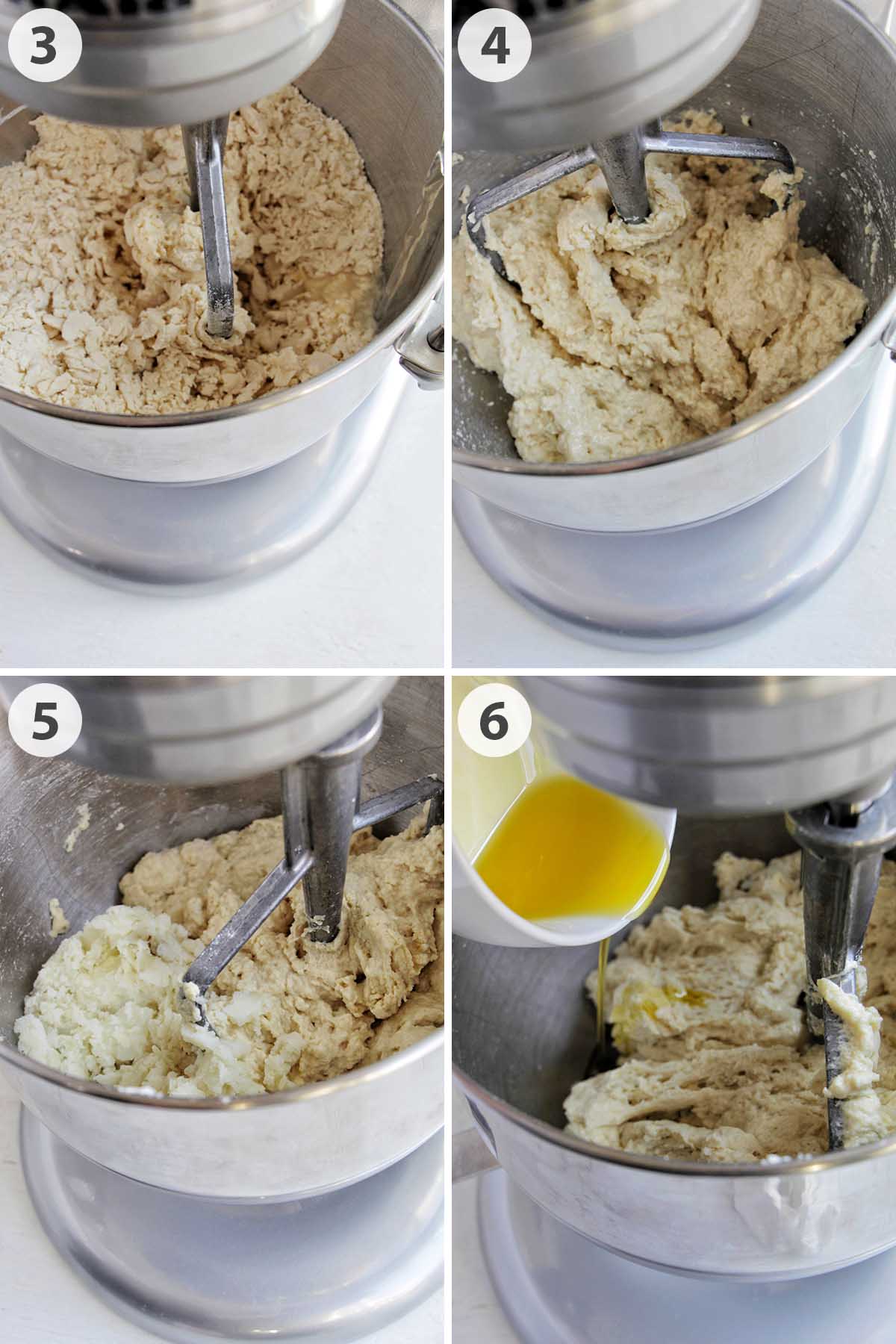
3. Next, it's time to start mixing up the dough. Mix bread flour, semolina, sugar, and active dry yeast in a stand mixer fitted with a paddle attachment on medium low speed. With the mixer running, slowly add water in three batches.
4. Allow the flour to completely absorb the water before adding the next batch. Since focaccia is a high-hydration dough, it can be easy to over-saturate the dough if you add in the water all at once.
5. Add in the potatoes and mix until combined with the rest of the dough.
6. Slowly pour extra virgin olive oil into the center of the dough in four batches. Mix the dough on medium low speed and allow the flour to absorb the oil before adding the next batch. Once you’ve added in your last batch of olive oil, add fine sea salt and mix thoroughly until all the oil has been absorbed.

7. Bump the mixer speed up to high and mix for an additional 1 - 2 minutes. The dough will be very wet and sticky.
9. Place the dough into an oiled bowl. Cover with plastic wrap and allow to rest in a warm, draft-free place until doubled in size. This stage is referred to as 'bulk ferment' in the baking world.
I like to place my dough near a window on cold days. If you live in a warm climate, the dough may rise significantly faster.
10. Once the dough has risen, place the covered dough in the refrigerator to rest for an additional 24 hours. This step helps to create delicious flavor in the dough, as well as aid in a nice crumb.
Next, it's time to make the topping. Whisk ⅓ cup (65 grams) extra virgin olive oil and ⅓ cup (75 grams) water in a small bowl until combined. You can do this ahead of time to have it prepped and ready to go once the dough has fully rested.
This olive oil and water topping is a trick I learned in culinary school. It's the secret to the perfect focaccia crust. Most people don't add water to the topping, but it creates a crispy top.
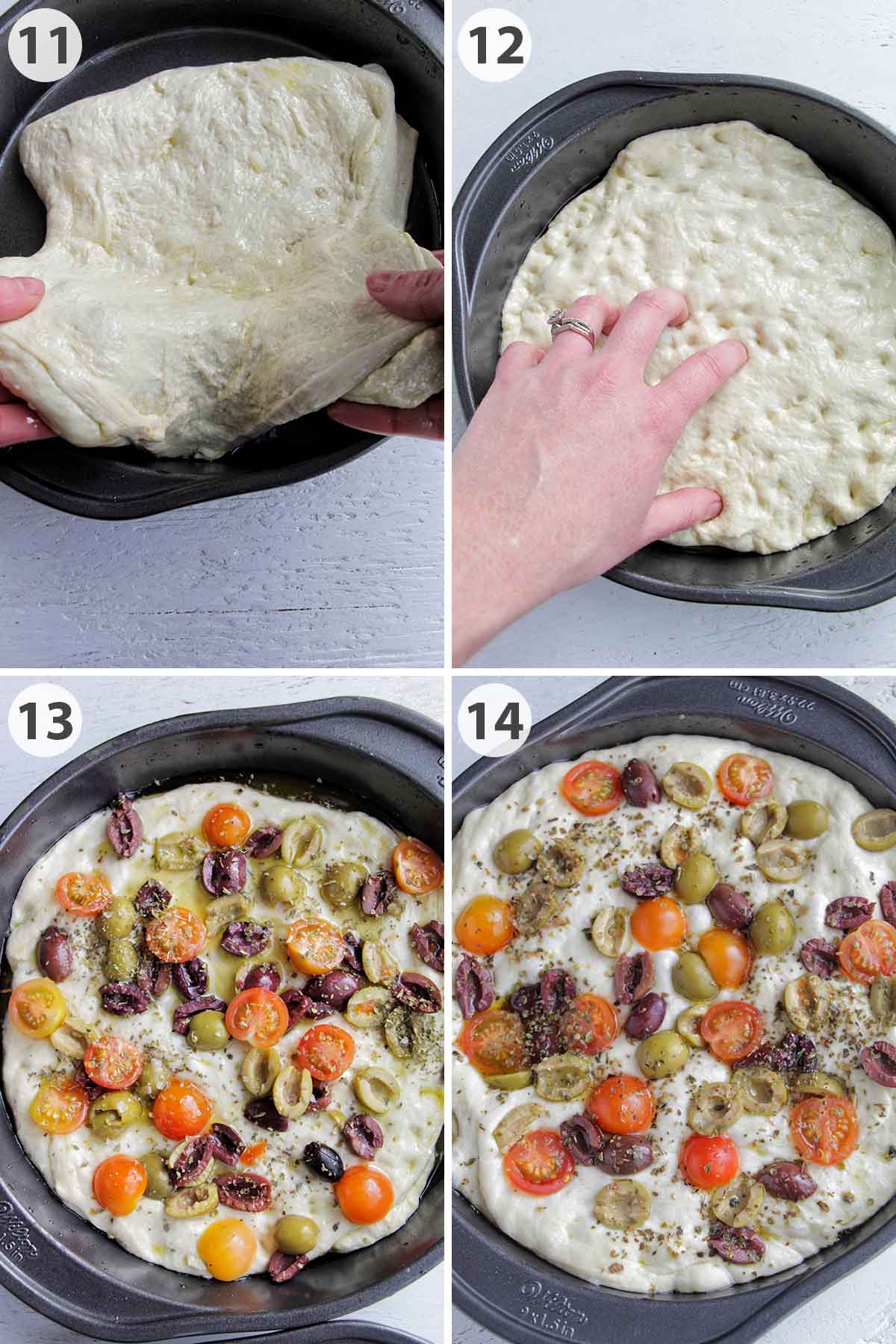
11. The next day, it's time to start preparing the focaccia so it's ready to bake. First, you'll need to generously oil the bottom and sides of four 9 inch (23 cm) round metal pans with extra virgin olive oil. This ensures the focaccia doesn't stick to the pan.
Cut the dough into four even pieces using a bench scraper. Place the dough into each metal pan and use gravity to allow the dough to naturally stretch until it reaches the edge of the pans. If you notice the dough pulling back to the center, allow it to rest in the pan(s) for an additional 10 minutes, then continue stretching.
12. Use your fingertips to make indentations on top of the focaccia dough. It's important to do this step before the dough has been proofed.
13. Top the dough with tomatoes and olives, then sprinkle with oregano and Maldon sea salt flakes. Evenly pour the water and oil mixture on top of each dimpled focaccia.
14. Cover the pans with plastic wrap and allow them to proof in a warm (75°F - 80°F or 24°C - 27°C), draft-free place until tripled in size, about 60 minutes.
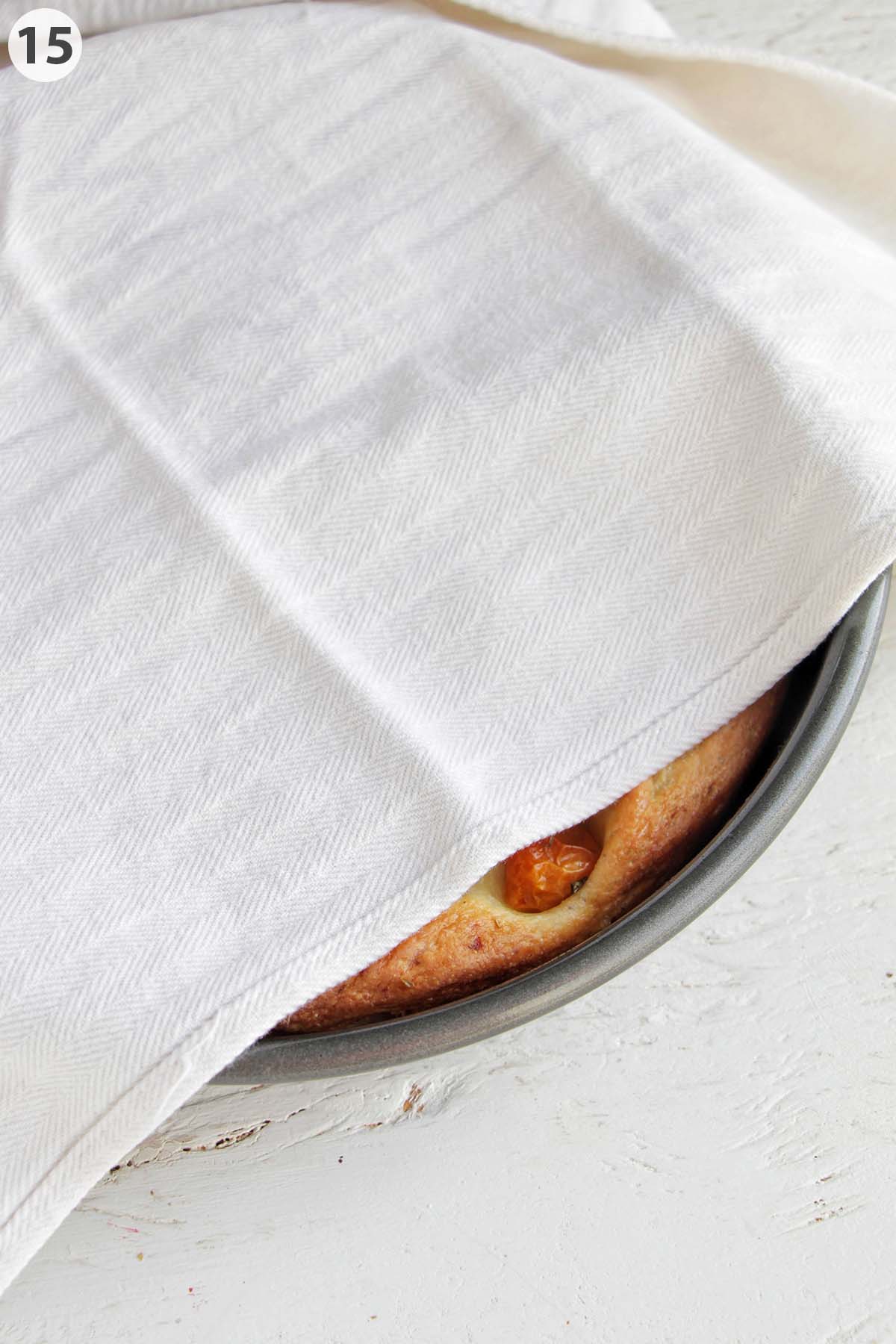
15. Finally, it's time to bake the dough. Place the oven racks in the upper and lower third slots and preheat your oven to 430°F (220°C). I like to use an oven thermometer to ensure the oven is properly heating.
Carefully remove the plastic wrap from the pans without knocking any air out of the bread dough. Bake for 35 - 40 minutes, rotating halfway through the baking process, until golden brown and crispy on the top.
Place focaccia on a cooling rack and cover with a tea towel. This helps the bread to stay super soft! After the focaccia has fully cooled, you can remove it from the pan and slice it into individual pieces.
The final step is reheating the focaccia before it's served. Focaccia in Italy is always baked twice.
To serve, heat oven to 350°F (180°C). Line a baking sheet with parchment paper and place focaccia slices on top. Bake for 12 - 15 minutes until warmed through and crunchy on the outside.
Expert Tips
- It's important to be organized when baking bread. Be sure to measure (mise en place) your ingredients before you begin baking. I'd also suggest reading through the recipe completely so you know what to expect.
- This dough has a long fermentation time, so it's helpful to come up with a baking schedule before jumping into the recipe. Here's the baking schedule I like to follow:
- Day 1, 9:00 am: Make the dough.
- Day 1, 9:30 am: Allow dough to rise (bulk ferment stage).
- Day 1, 11:30 am: Place dough in the refrigerator for 24 hours.
- Day 2, 11:30 am: Portion and proof dough.
- Day 2, 1:00 pm: Bake the bread.
- If you're going to eat the focaccia right away, it can be stored in an airtight bag at room temperature for 3 - 5 days. Then, follow the serving instructions listed on the recipe card below to reheat focaccia.
- Want to keep your focaccia fresh for a longer time? Store the focaccia in the freezer. Don't worry, it doesn't change the flavor or texture of the bread. To do this, line a baking sheet with parchment paper. Place sliced focaccia on the baking sheet and freeze, just until firm. Place the frozen bread in an airtight container in the freezer until you're ready to serve. Then, follow the serving instructions listed on the recipe card below for the frozen bread.
Recipe FAQs
The dough requires several hours to rise. If you live in a cold environment, the rising time can take even longer.
If you've waited 5 - 8 hours for the dough to rise and it still hasn't doubled in size, your yeast is likely dead. I would suggest purchasing new yeast and re-making the recipe.
Focaccia is an exceptionally light and airy bread. When baking, handle the dough with care to preserve its airiness.
Be particularly cautious during the proofing stage, the period before the bread enters the oven. Avoid re-indenting the bread with your fingers, as this action would expel all the air from the dough, resulting in a denser texture.
Also, ensure that your yeast hasn't expired. The use of expired yeast can contribute to dense focaccia as it may not effectively facilitate proper rising.
I like to allow my dough to rise during the bulk fermentation stage near a sunny window. However, this is not necessary if you live in a hot climate.
For the proofing stage, I place it on top of my oven. Turn your oven on to a low temperature (170°F - 200°F or 76°C - 93°C). This will allow the top of the oven to heat up just enough, around 75°F - 80°F (24°C - 27°C), and create the perfect environment.
Be sure not to place the bread inside the oven at this stage.
Yes! Allowing the dough to ferment for an additional 24 hours in the refrigerator helps to enhance the flavor and the crumb (texture) of the focaccia.

More Focaccia Bread Recipes
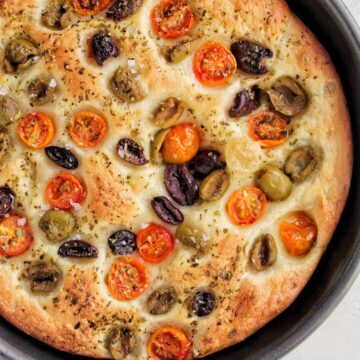
Focaccia Barese
Equipment
- medium sized pot
- 4 (9 inch or 23 cm) metal pie pans
- bench scraper or knife
Ingredients
Focaccia Dough
- 1 large Russet potato scrubbed, peeled, and chopped into 1 inch (2.5 cm) pieces
- 3 cups bread flour
- 1 ¾ cups semolina
- 3 teaspoons granulated sugar
- ¾ teaspoon active dry yeast
- 2 cups water around 80°F (27°C) - 100°F (38°C)
- ¼ cup extra virgin olive oil
- 2 teaspoons fine sea salt
Focaccia Toppings
- ⅓ cup plus more for greasing the pans extra virgin olive oil
- ⅓ cup room temperature water
- 1 ½ cups cherry tomatoes sliced in half
- 1 ¼ cups pitted olives sliced in half
- 2 teaspoons dried oregano
- 1 teaspoon Maldon sea salt flakes
Instructions
For Focaccia Dough
- Add potato to a medium sized pot and fill with cold water until the potatoes are fully covered. Bring the water to a boil and cook uncovered until the potatoes are tender and can easily be pierced by a knife, about 5 - 8 minutes once boiling. Drain and mash the cooked potato with a fork. Measure out 1 cup (200 grams) of firmly packed mashed potato.
- Mix bread flour, semolina, sugar, and active dry yeast in a stand mixer fitted with a paddle attachment on medium low speed. With the mixer running, slowly add water in three batches. Allow the flour to completely absorb the water before adding the next batch.
- Combine potatoes; mix thoroughly.
- Slowly pour extra virgin olive oil in the center of the dough in four batches. Mix on medium low speed and allow the flour to absorb the oil before adding the next batch. Once you’ve added in your last batch of olive oil, add fine sea salt and mix thoroughly until all the oil has absorbed.
- Bump the mixer speed up to high and mix for an additional 1 - 2 minutes. The dough will still be very wet and sticky.
- Place the dough into an oiled bowl. Cover with plastic wrap and allow to rest in a warm, draft-free place until doubled in size.
- Place the covered dough in the refrigerator to rest for an additional 24 hours.
For Focaccia Toppings
- Generously oil the bottom and sides of four 9 inch (23 cm) round metal pans with extra virgin olive oil. Cut the dough into four even pieces using a bench scraper. Place the dough into each metal pan and use gravity to allow the dough to naturally stretch until it reaches the edge of the pans. If you notice the dough pulling back to the center, allow it to rest in the pan(s) for an additional 10 minutes, then continue stretching.
- Whisk ⅓ cup (65 grams) extra virgin olive oil and ⅓ cup (75 grams) water in a small bowl until combined.
- Use your fingertips to make indentations on top of the focaccia dough. Top the dough with tomatoes and olives. Sprinkle with oregano and Maldon sea salt flakes. Evenly pour the water and oil mixture on top of each dimpled focaccia.
- Cover the pans with plastic wrap and allow to proof in a warm (75°F - 80°F or 24°C - 27°C), draft-free place until tripled in size, about 60 minutes.
- Place oven racks in the upper and lower third slots. Heat oven to 430°F (220°C).
- Carefully remove plastic wrap from pans without knocking any air out of the bread dough. Bake for 35 - 40 minutes, rotating halfway through the baking process, until golden brown and crispy on the top. Place focaccia on a cooling rack and cover with a tea towel. Allow focaccia to cool to room temperature before removing from the pan and slicing into individual pieces.
- To serve, heat oven to 350°F (180°C). Line a baking sheet with parchment paper and place focaccia slices on top. Bake for 12 - 15 minutes until warmed through and crunchy on the outside.


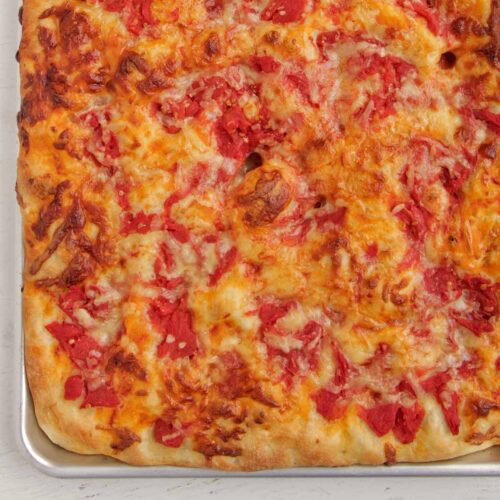



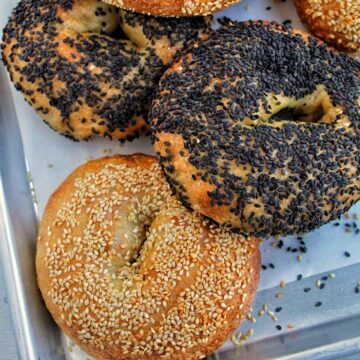
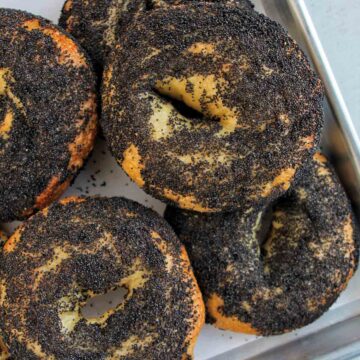
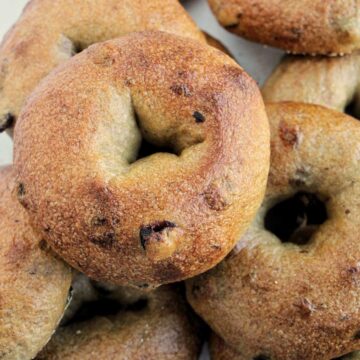
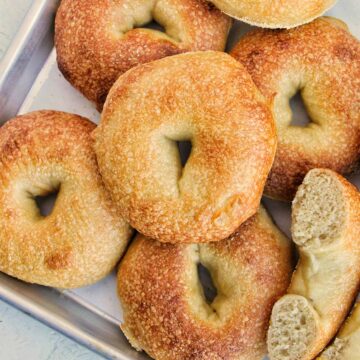
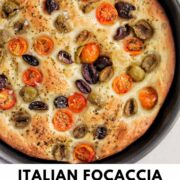
Hairstyles
I’m so in love with this. You did a great job!!
Jessica Mode
Thanks! I'm so glad you love it!